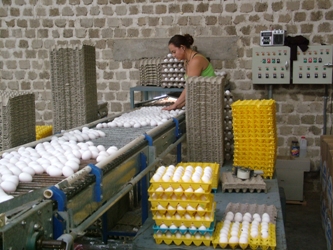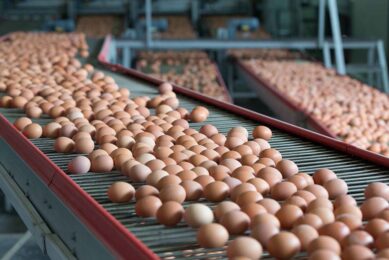Making eggs fit for function

Table eggs have gained an important role in nutrition. They are full of rich and valuable nutrients. Mineral deficiencies may lead to failures in function, however. A consideration of the inorganic component of the table egg, helps understanding on how to improve quality and make eggs fit for function.
By Prof. Sally E. Solomon, senior research fellow, University of Glasgow, Scotland
As a source of essential nutrients, the egg is unrivalled. It is a complex of protein, carbohydrates, fat, vitamins (A, D, B1, B12 and riboflavin) and has a mineral profile which includes iron, phosphorus, calcium, copper, iodine, magnesium, manganese, potassium sodium, zinc, selenium and sulphur.As might be expected of a chamber designed primarily to nourish and protect the developing embryo, many of the proteins display antibacterial properties. The table egg is likewise invested with the ability to withstand bacterial ingress.
The mineral component on the other hand affects its role in processes as diverse as the maintenance of albumen quality, the elasticity of the paired shell membranes and shell formation. Defects in the formation of any of these components will have a profound effect on the functional capabilities of the table egg.Liquid egg coagulates when heated (cakes, bread), when emulsified the phospholipids and lipoproteins in egg yolk will form the basis of dressings for salads etc., when beaten, uncontaminated egg white will foam (meringues, mousse) and when boiled the egg will give up its shell and membranes to reveal its intact, solid contents.
So much for theory – in practice from my own experience, sponge cakes rarely rise, yolk always contaminates the egg white during separation and the shell of the hard-boiled egg rarely separates from the egg white without removing with it a plug of the latter. These failures in function can be explained in part by considering the role played by various fractions of the egg and the effects of mineral deficiencies in their formation.
Surrounded by membrane
Much has been written about the foaming properties of egg white and the changes that occur in the molecular configuration of the proteins during the process. Essential to the latter is the assiduous separation of yolk from egg white since the presence of even a trace of the triglyceride fraction of the yolk has been reported to reduce the volume of the foam by up to two thirds. The yolk is surrounded by the vitelline membrane. This two-layered proteinaceous structure is easily ruptured with handling and with prolonged storage it stretches and disintegrates as the yolk absorbs water from the egg white. This disintegration then permits the otherwise physically separated fractions of the egg contents to mix.
Much has been written about the foaming properties of egg white and the changes that occur in the molecular configuration of the proteins during the process. Essential to the latter is the assiduous separation of yolk from egg white since the presence of even a trace of the triglyceride fraction of the yolk has been reported to reduce the volume of the foam by up to two thirds. The yolk is surrounded by the vitelline membrane. This two-layered proteinaceous structure is easily ruptured with handling and with prolonged storage it stretches and disintegrates as the yolk absorbs water from the egg white. This disintegration then permits the otherwise physically separated fractions of the egg contents to mix.
With the exception of the phosphorus rich yolk which develops in a hierarchical manner within the ovary, all other components of the egg are synthesised within the oviduct. Thus the multi-layered albumen secreted by the magnum is known to contain an array of protein types (>100) in addition to its high water content (90%). During the beating process, changes occur in the molecular configuration of many of the proteins with the precipitation of some of the latter at the liquid-air interface.
Egg white plays vital role
But egg white and in particular thick egg white has a vital role to play in the process of egg formation. It is rich in ovomucin and with respect to its ionic composition is purported to contain twice as much calcium and magnesium as the surrounding liquid albumen. These ions have a role to play in the viscosity of thick egg white, a necessary prerequisite to the deposition of the paired membrane fibres (Figure 1) which in turn will support the weight and growth of the true shell.
In a normal egg the membrane fibres enclose the yolk and albumen in such a way as to restrict the inward migration of calcium salts from the solution in which the forming egg is bathed. Anomalies do occur, as evidenced by the aforementioned difficulty when trying to peel a boiled egg without extracting a plug of albumen. Under such circumstances the topography of the interlacing web of fibres has changed, possibly as a result of damage to the isthmus region of the oviduct which is responsible for their synthesis.
In such a situation, the calcium salts are free to move towards the egg white where, in the presence of proteins which facilitate precipitation, they anchor and so bind the shell to the contents. Prior to the main phase of shell formation the egg acquires a volume of nutrient rich fluid which serves to swell the contents to their final size. Essential to this process is the elasticity of the membrane fibres. Failure to expand will distort egg shape.
Four distinct layers
The process of shell formation and the effects of both physiological factors (e.g. age) and external environmental factors (e.g. housing) on the ability of the bird to produce a ‘normal’ shell capable of withstanding the effects of crushing and/or impact damage are well documented. During downgrading eggs are routinely removed from the selection system because of defects in shell colour and texture, egg shape and the presence of cracks. The aetiology of these diverse forms has been the subject of many communications. However their control, or better still, their eradication awaits resolution.
The process of shell formation and the effects of both physiological factors (e.g. age) and external environmental factors (e.g. housing) on the ability of the bird to produce a ‘normal’ shell capable of withstanding the effects of crushing and/or impact damage are well documented. During downgrading eggs are routinely removed from the selection system because of defects in shell colour and texture, egg shape and the presence of cracks. The aetiology of these diverse forms has been the subject of many communications. However their control, or better still, their eradication awaits resolution.
The shell is a polycrystalline structure and comprises four distinct layers, the mammillary layer, the palisade layer, the vertical crystal layer and the cuticle. In terms of the inorganic constituents, calcite is the dominant crystal form, whilst magnesium is involved in the formation of the basal layer of the shell. Phosphorus is present towards the outer surface of the egg. The latter is recognised as a crystal poison and is considered to play a role in the termination of shell formation. Manganese, a transition metal, is also found within the organic/inorganic complex and influences the stability of the shell during its growth.
It is the complex interaction between the inorganic and organic components of the shell which enables the formation of a package capable of providing both physical protection to the contents and a barrier to bacterial penetration.Stress (disease and environment), bird age, housing, management and diet have a role to play in the formation of ‘seconds’. Rarely is there one causative factor and undoubtedly the starting point in any attempt to redress the balance must be a consideration of the health status of the flock. Achieving best performance in any flock therefore requires a balance to be made in the provision of both micro and macronutrients.
Trace minerals beneficial
Within the category of micronutrients one can include vitamins and essential minerals such as zinc, copper and iron. The form in which these minerals are delivered is important. Research has shown that inorganic minerals are poorly absorbed in the gut and as a consequence a greater proportion (compared with organic sources) is excreted. With demands for reduced mineral output, expected of all sectors of the farming industry, considerable effort has been directed towards the provision of these divalent cations in a more ‘environmentally’ friendly package.
According to the literature, when a mineral is bound to a ligand it is not only protected but can be more readily absorbed from the diet so permitting lower levels of inclusion.Data on the effect of Bioplex zinc, manganese and selenium (the latter in the form of Sel-Plex) illustrate improvements in egg production, shell thickness and the viscosity of egg white and the ease with which the shell membranes expand to accommodate the transfer of the “plumping” fluid prior to shell formation. In a trial involving broiler breeders, the inclusion in the diet of Sel-Plex at 0.3ppm from the beginning of lay improved hatchability after 45 weeks of age.
A comparison of the structural and physical qualities of control and experimental eggs confirmed within the latter the improved association between the membrane fibres and the initial phase of calcification.There are occasions when nature and experimental design can conflict and in a recent trial involving layer birds neither sodium selenite nor Sel-Plex alone were able to offset the cellular breakdown caused by the unanticipated disease event. As a consequence of disease, the shells displayed a variety of abnormal crystal forms which reduced both their breaking strength and fracture toughness (Figure 2). In marked contrast the birds in this randomised trial fed on a diet containing Bioplex Zn, Fe, Cu and Mn together with Sel-Plex displayed no cellular dysfunction and the shells even at the end of lay were structurally sound.
Oviducal damage can vary from cell death to minor changes in the appearance of the surface epithelium which lines the tract. It is reversible but bird age and the degree of damage will influence the time of return to normal productivity. When challenged with a disease event, the immune system becomes compromised and nutritional supplementation is generally the first recourse. The results of the layer trial already referred to underline the need in such circumstances to involve the synergistic action of several minerals, amongst which zinc, copper and selenium in addition to their many other functions are recognised, to improve the bird’s ability to fight disease.
Join 31,000+ subscribers
Subscribe to our newsletter to stay updated about all the need-to-know content in the poultry sector, three times a week. Beheer
Beheer








 WP Admin
WP Admin  Bewerk bericht
Bewerk bericht